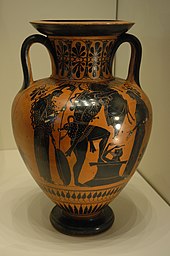Leagros group
The leagros group is one with a provisional names named group Attic - black-figure vase painters. The works are dated to the last 20 years of the 6th century BC. Dated.
The Leagros group is the last significant group of Attic vase painters of the black-figure style to show large-format pictures on vases. Their importance is so great that their creative period is also known as the “Leagros period”. The group is assigned about 400 vases, mostly hydrates and neck amphorae , which comprise about half of the vases assigned to the group. In addition, other amphora shapes, craters , lekyths and, in smaller quantities, other shapes are painted. The group got its emergency name from the Kalos name Leagros, which was applied to five vases assigned to the group .

Hydria of the group are similar to those of the Antimenes painter , but they often show more pronounced lips and flatter but wider shoulders. In place of the earlier animal frieze predellas and the frame strips adorned with ivy leaves, there are now palmettes with wide, separate leaves. They are arranged in rounded loops or loops. They show a pattern that until then was only rarely shown on black-figure vases and that was particularly popular in the red-figure vase painting that was created in the time of the Leagros group . Sometimes representatives of the group adopt white-ground necks for their amphorae, which again goes back to the Antimenes painter. The ornamentation of the neck amphora also corresponds to its ornamentation scheme, but the plant ornaments that adorn the necks are better elaborated and the lotus flowers are more reminiscent of celery bushes.
The figure pictures once again show the power and complexity of the black-figure style. There are intricate character scenes and overlapping characters shown. The scratches are powerful and clear, the representation of anatomical details remains moderate. Opaque colors are only used cautiously. Garment folds and garment patterns are only shown sometimes and then only to a moderate extent. With this, the painters of the group show what the black-figure style can achieve. But at the same time, the artists in the pioneering group showed what the new style could do. You almost indulge in anatomical and clothing details. In the Leagros group, the more limited means of the new style manage to adopt some of the innovations in a practicable form. If muscles or folds of clothing are shown, then in a greatly reduced manner. The figures' small eyes are also striking. They particularly benefit from the new technology for perspective and expansive representations, which, however, continue to be rare. The figures all show a heroic build and facial expression. In comparison with the figures of the Antimenes painter, they seem quite sturdy. The group does not waste any space, the picture fields are always well filled and do not appear overloaded only because of the drawing skills of the painters. The picture compositions are mostly coherent and charged with tension. Sometimes details can protrude from the actual image fields.
Several other subgroups and individual painters could be identified within the group, which is not always easy, however, as the styles of the individual representatives are very similar. The most important here are the Acheloos painter and the Chiusi painter . The group is particularly fond of showing mythological themes; here again depictions from the Trojan War and the adventures of Heracles are particularly preferred. Achilles and Ajax are shown playing a board game several times . Some pictorial themes are taken up for the first time by painters from the Leagros group, others are shown and interpreted in a new way by the group. At the same time, something similar happens in the red-figure style, but both developments are to be viewed separately from one another, although influencing one another cannot be ruled out. A workshop connection to the pioneers is possible, for example Euphronios , Phintias and Euthymides also use the Kalos names Leagros . Overall, the connection and the influence of the two groups among and on each other is controversial in research. John Boardman sees them coexist, Heide Mommsen sees strong interactions.
literature
- John D. Beazley : Attic Black-Figure Vase-Painters , Oxford 1956, pp. 354-391, 695f.
- John D. Beazley: Paralipomena. Additions to Attic black-figure vase-painters and to Attic red-figure vase-painters . Oxford 1971. pp. 160-172.
- John D. Beazley: The Development of Attic Black-figure . Rev. ed. Dietrich von Bothmer and Mary B. Moore. Berkeley 1986, ISBN 0-520-05593-4 , pp. 74-80.
- John Boardman : Black-Figure Vases from Athens. A handbook (= cultural history of the ancient world . Vol. 1). Philipp von Zabern, Mainz 1977, ISBN 3-8053-0233-9 , pp. 120-122.
- Heide Mommsen : Leagros Group. In: The New Pauly (DNP). Volume 6, Metzler, Stuttgart 1999, ISBN 3-476-01476-2 , Sp. 1203.

